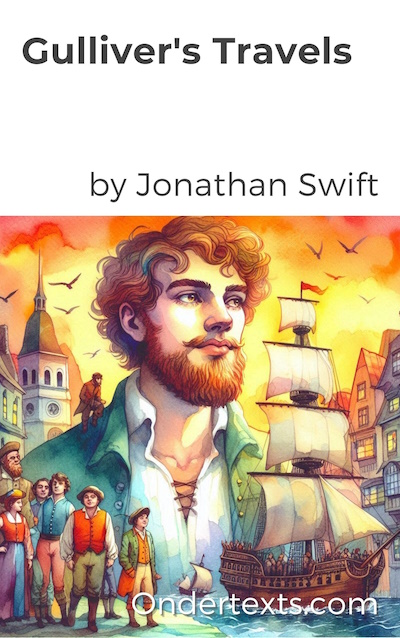Gulliver's Travels
by Jonathan Swift
 Gulliver's Travels by Jonathan Swift
Gulliver's Travels by Jonathan SwiftLemuel Gulliver, a surgeon and sea captain, embarks on four extraordinary voyages. In Lilliput, he encounters tiny people; in Brobdingnag, giants; in Laputa, absurd scientists; and in the land of the Houyhnhnms, rational horses. Swift’s satire critiques human nature, politics, and society.
Summary
In Jonathan Swift’s “Gulliver’s Travels”, Lemuel Gulliver embarks on four distinct voyages, each revealing a different aspect of human folly and societal flaws. In Part I, Gulliver finds himself in Lilliput, a land of tiny people, where he becomes embroiled in the petty politics and absurd customs of the Lilliputians. Their trivial disputes, such as the correct way to crack an egg, satirize the pettiness of human conflicts and the arbitrary nature of political power[1†].
In Part II, Gulliver travels to Brobdingnag, a land of giants, where his small size makes him a curiosity and a subject of study. The Brobdingnagians’ straightforward and moral society contrasts sharply with the corruption and vice Gulliver observes in his own country. This section critiques the moral and ethical shortcomings of European society through the eyes of the giants, who view Gulliver’s descriptions of his homeland with horror and disbelief[1†][2†].
Part III takes Gulliver to the floating island of Laputa and its surrounding territories, where he encounters absurdly impractical scientists and philosophers. The inhabitants of Laputa are so engrossed in their abstract theories and experiments that they are oblivious to practical realities. This part of the narrative satirizes the impracticality of theoretical knowledge disconnected from real-world applications and mocks the pretensions of intellectuals who are detached from everyday life[1†][3†].
Finally, in Part IV, Gulliver reaches the land of the Houyhnhnms, rational horses who live in a society governed by reason and devoid of lies, deceit, and vice. The Houyhnhnms’ society is contrasted with that of the Yahoos, brutish and savage human-like creatures. Gulliver’s admiration for the Houyhnhnms leads him to a profound disillusionment with humanity, as he comes to see humans as inherently corrupt and irrational. This final voyage serves as Swift’s most scathing critique of human nature, highlighting the potential for reason and virtue while condemning the baseness and depravity of mankind[1†][2†][3†].
Overall, “Gulliver’s Travels” addresses themes of human nature, politics, society, and the limits of human knowledge. Swift’s masterful use of satire exposes the absurdities and vices of his contemporary world, making the novel a timeless critique of human folly.
| Avaialble Works | Source | Type | |
|---|---|---|---|
| Gulliver's Travels by Jonathan Swift | Ondertexts | ebook | READ |
References and Citations:
- Wikipedia (English) - Gulliver's Travels [website] - link
- Britannica - Gulliver’s Travels: novel by Swift [website] - link
- Goodreads - Book: Gulliver’s Travels [website] - link
Text is available under the Creative Commons Attribution-ShareAlike License 4.0; additional terms may apply.
Ondertexts® is a registered trademark of Ondertexts Foundation, a non-profit organization.